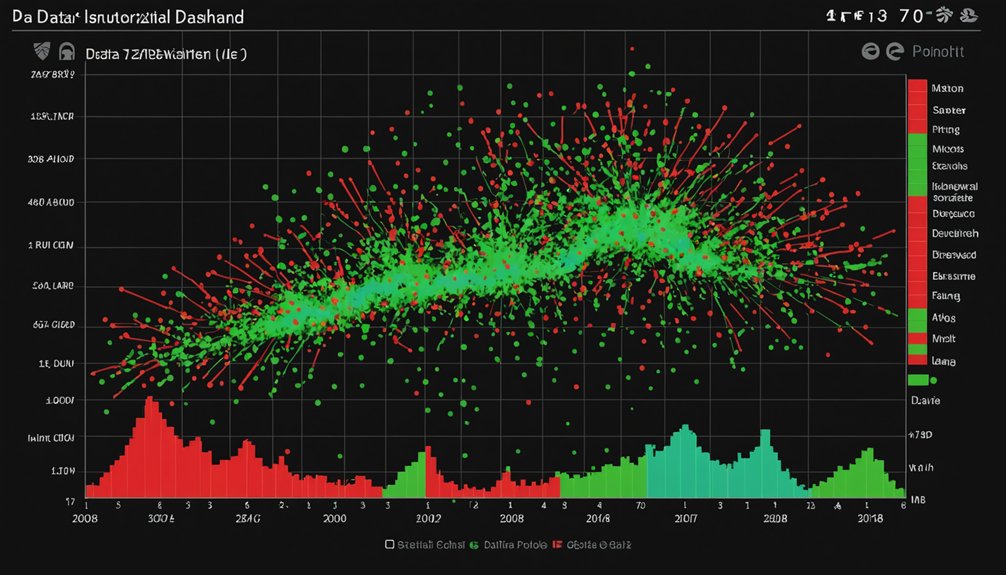Anomaly detection spots outliers in data. No magic here—just methods ranging from basic statistics to fancy deep learning. It’s essential for catching fraud, identifying tumors, and spotting hackers. Traditional approaches use z-scores and boxplots, while machine learning methods learn patterns from historical data. Deep learning handles complex anomalies but demands serious computing power. Different techniques suit different scenarios. The right method depends on your data complexity and available resources. Dig deeper and those hidden oddities won’t stay hidden for long.

While most data follows predictable patterns, it’s the outliers that often tell the most interesting stories. Anomaly detection is the art and science of finding these weird data points that scream “something’s not right here!” It’s like having a security guard for your data, constantly on the lookout for sketchy behavior. From catching hackers to spotting tumors in medical scans, anomaly detection serves an essential role across industries. Without it, we’d miss the unusual events hiding in plain sight.
Statistical methods offer the simplest approach. They’re the old-school detectives of the anomaly world, using mathematical formulas like z-scores and boxplots to flag outliers. Easy to understand? Yes. Perfect for every situation? Not even close. They fall flat when data gets complex. Modern machine learning algorithms analyze vast amounts of data to detect fraud patterns more accurately than traditional statistical methods. Natural language processing enables more sophisticated analysis of security threats across diverse data types.
Statistical methods are like data detectives with basic tools—effective for simple cases but clueless when the mystery gets complicated.
Enter machine learning methods. These techniques actually learn what normal looks like by studying historical data. Support Vector Machines and k-Nearest Neighbors algorithms can spot oddities that basic stats would miss. The downside? They’re data-hungry beasts. No labeled examples, no party.
Deep learning takes things to another level. Using neural networks like autoencoders and CNNs, these methods detect subtle irregularities in massive datasets. They’re impressive but demanding. You need serious computing power and tons of data to make them work. Autoencoders are particularly effective as they can identify anomalies based on reconstruction errors when trying to reproduce normal data patterns.
Density-based methods like DBSCAN focus on how data points cluster together. Stragglers get flagged as anomalies. These work great with spatial data but get finicky about parameter settings.
For data that changes over time, there’s time series analysis. ARIMA and STL decomposition can spot when your stock portfolio is behaving strangely or predict when your air conditioner might fail. Not exactly beginner-friendly though.
Choosing the right method depends on your data and resources. Early detection through anomaly monitoring can lead to significant financial savings by helping businesses prevent operational disruptions that might otherwise result in costly downtime. The trickiest part? Figuring out if that outlier is actually important or just noise. One person’s anomaly is another’s random blip. That’s the messy reality of outlier detection.
Frequently Asked Questions
How Do Anomaly Detection Algorithms Perform in High-Dimensional Data?
High-dimensional data is a nightmare for anomaly detection algorithms. They struggle big time. Data gets sparse, distances become meaningless, and everything looks like an outlier. Seriously.
Dimension reduction techniques like PCA and autoencoders are absolute lifesavers here. Some algorithms adapt better than others—the stray algorithm handles multimodal distributions while LOF often chokes in higher dimensions.
Hybrid approaches combining multiple methods? Smart move. Real-time performance suffers too. It’s complicated, folks.
Can Transfer Learning Improve Anomaly Detection in New Domains?
Transfer learning absolutely improves anomaly detection in new domains. It’s a no-brainer solution when labeled data is scarce. The technique leverages knowledge from data-rich source domains and applies it to target domains.
Domain adaptation helps bridge differences between datasets. Unsupervised methods like autoencoders work particularly well.
Still has challenges though. Domain discrepancy can mess everything up if the domains are too different. Computational costs aren’t trivial either.
But overall? Worth the effort.
How to Balance False Positives and False Negatives?
Balancing false positives and negatives is tough. No way around it. Organizations need to optimize thresholds based on their specific risk tolerance—what costs more: missing real threats or chasing ghosts?
Ensemble methods help, combining multiple models to catch what single ones miss. Cost-sensitive learning works too, weighting errors differently during training. Regular feedback loops are essential. Data quality matters, obviously.
The balance shifts by domain—healthcare can’t afford missed anomalies, retail might tolerate a few false alarms.
What Are the Computational Requirements for Real-Time Anomaly Detection?
Real-time anomaly detection demands serious computational muscle. High-performance CPUs and GPUs aren’t optional—they’re essential.
Systems need distributed processing frameworks like Apache Spark to handle massive datasets in parallel. Memory? Better optimize it. Storage? Must be lightning-fast.
Architecture matters too. Cloud integration provides the scalability these systems desperately need.
Streaming data processing isn’t a luxury—it’s required for instant detection.
The algorithms themselves? They’d better be computationally efficient. No time for resource hogs when anomalies wait for no one.
How Do You Validate Anomaly Detection Results Without Labeled Data?
Validating anomaly detection without labeled data is tricky. Analysts typically rely on statistical methods to establish normal behavior baselines, then identify deviations.
Unsupervised metrics like silhouette scores help evaluate clustering quality. Distance and density-based approaches spot outliers through spatial relationships.
Domain expertise? Essential for context. Some use pseudo-labeling or ensemble methods to improve robustness.
And let’s face it—continuous monitoring matters. Models need regular updates with fresh data to stay relevant. No shortcuts here.




